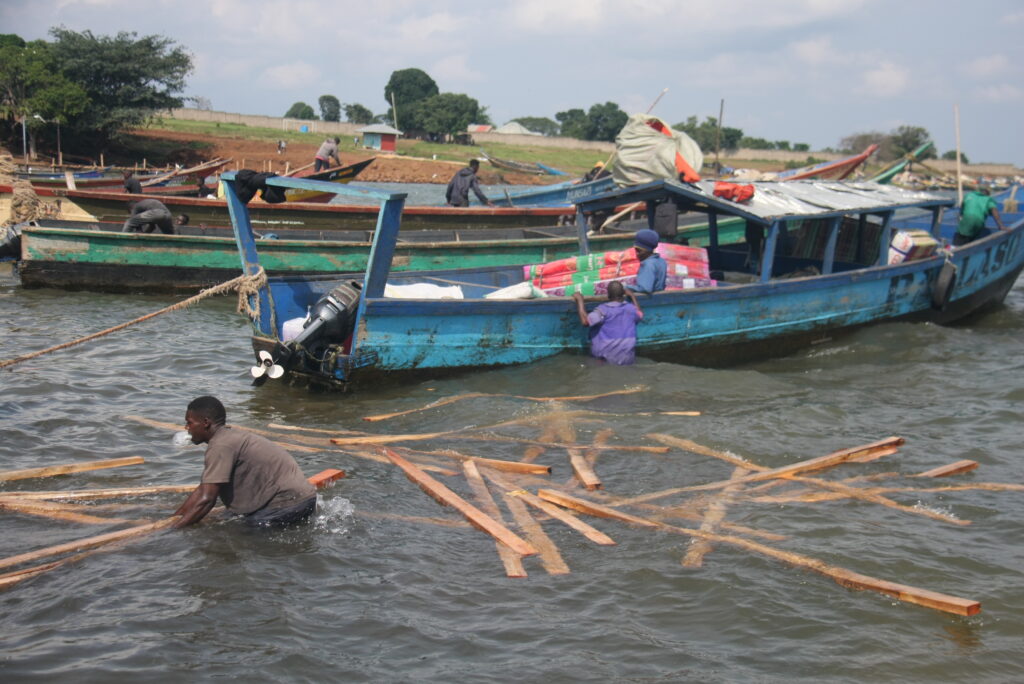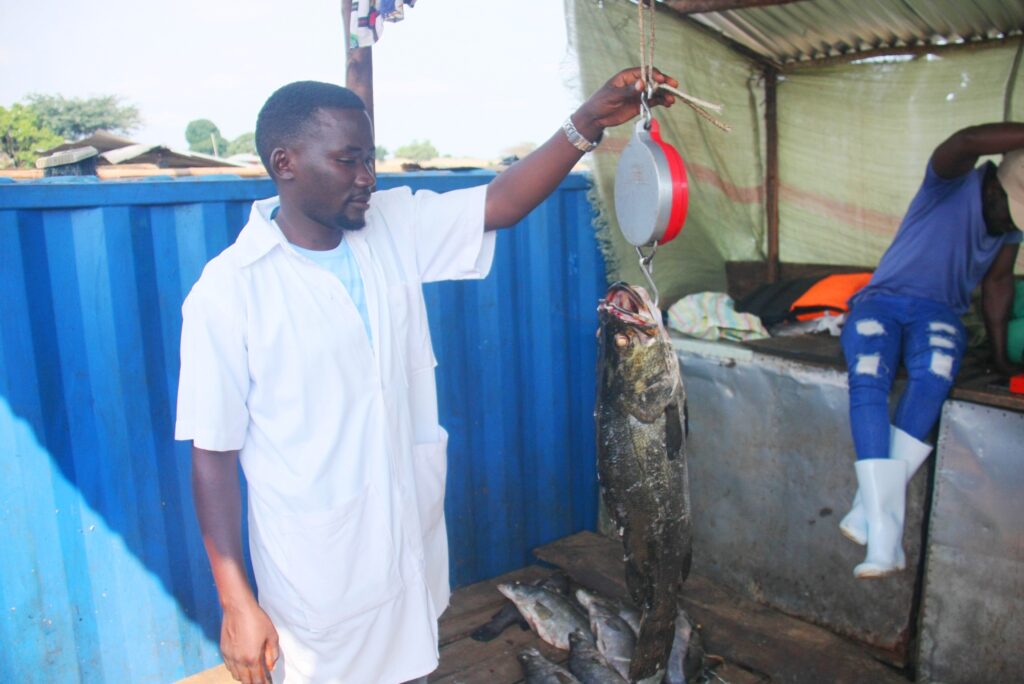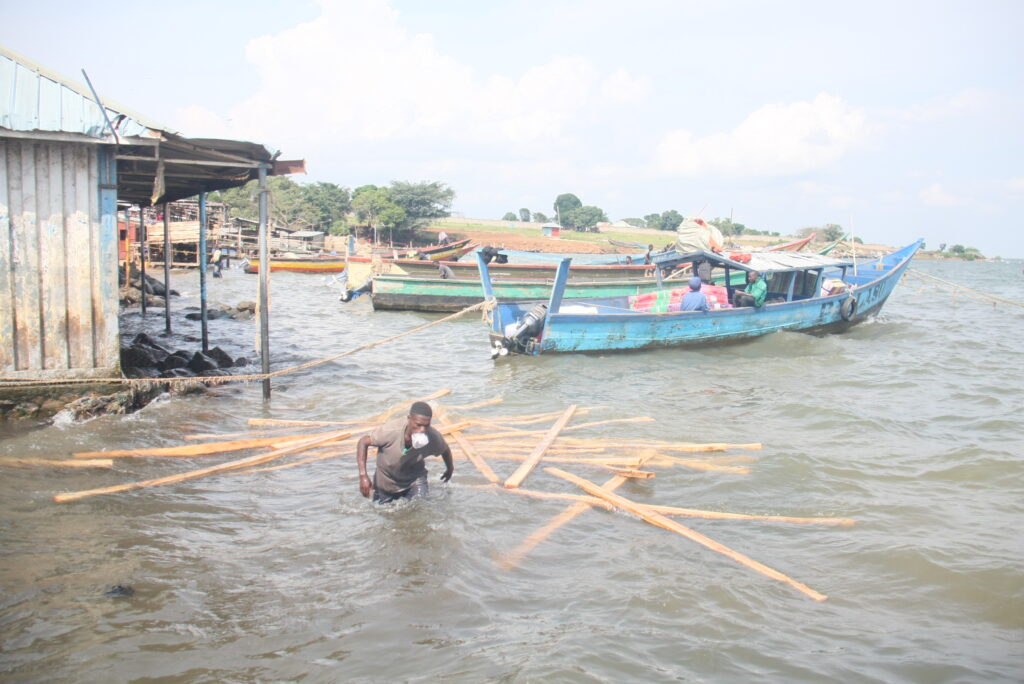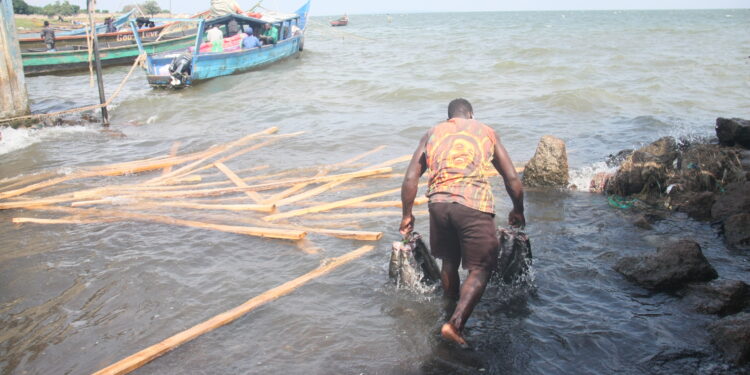Previously, South America was the main source of this highly valued fish maw but the new stringent regulated fishing systems has made Lake Victoria and Lake Albert the new sources of the maw.
It’s not only a cuisine in China and Hong Kong, but also traditional medicine to boost immunity and also raw material to make surgical threads.
It is served in soups or stews in addition to being used as a source of collagen. It is also used to make water-resistant glue and in the production of isinglass, a refining agent involved in the manufacture of beer and wine.
This illegal trade also threatens the existence of the two biggest water bodies in Uganda with pollution because after killing the young Nile Perch, the rest of the fish is thrown into water which causes pollution.
The Chairman of Kasenyi Fishermen Association, Frank Luwera says this illegal trade starts with fishermen who kill the juvenile fish, hide the maw to evade arrest and dump the dead fish in the water.

A man wades through the water with timber logs destined for the islands at Kasenyi Landing site
“When they come back to the landing sites, they hide the maw in laptop bags [backpack] to avoid detection,” he says.
At these landing sites, there are Ugandan middlemen waiting who then move this illegal item to the Indian and Chinese traders with companies that export it to Hong Kong and China. “These Chinese and Indian traders have houses where they keep these items before they are sold to the companies that export to Asia,” he says.
It is again moved from these houses and sold to the companies with license to export the maw.
At the premises of these companies, this illegal swim bladder is mixed and packed together with the legal ones before the cargo is transported through Entebbe Airport to China and Hong Kong.
According to the investigation done by the East African Centre for Investigative Reporting with the support from Earth Journalism Network, two houses located Munyonyo and Garuga near the shores of Lake Victoria were identified as places where this illegal trade allegedly takes place.
They have tall fences with Cameras and private security guards with no sign that there is any business taking place inside.
One of the guides who is also a fisherman identified these houses during the investigation. He says the Chinese traders involved can even give advance payments to the fishermen involved in killing the young Nile Perch.
“Abo Tebaffayou oba enuuni ya Mpuuta nkadde or nto [Those Chinese don’t care whether the maw is from the young or old Nile Perch. What they want is the maw,” he said.
There is still little knowledge of this trade among the fishing communities and even traders in Uganda, which in itself shows deep suspicions surrounding this trade. “These Chinese cannot tell us what this maw is used for. They are telling us that it’s medicine. But again you hear stories that it’s used for witchcraft,” the guide says.
The thriving trade has seen the price of maw steadily increase from 2$ in early 2000s to USD200$ in 2024 per kg, representing an increment of about 10000%.
On the international market, maw will fetch between $450–$1,000 per kg depending on the market dynamics and quality of product.
The government has instituted strict regulations against illegal fishing including deployment of a military unit called Fishing Protection Units, but the vice has continued. These fishermen have continued to use illegal and banned fishing nets.
According to sources at the Ministry of Fisheries, these illegal fishnets are brought from China through Tanzania and smuggled into Uganda.
Indeed the Spokesperson of the military Fish Protection Unit, Lt Reuben Ndifura confirmed the smuggling of these illegal nets into the country. He said two raids carried out on January 12, 2024 on the stores managed by these smugglers and nets worth shs4bn were impounded and burnt.
Interestingly, one of the places raided was the building that houses the American Growth Opportunity Act project which manufactures textiles that were being exported to America before Uganda was suspended for passing the Anti-Homosexuality Act
Under AGOA, the legislation signed by former President Bill Clinton in 2000, gives at least 35 Sub-Saharan countries an opportunity to export 6,000 products tax-free to the American market and Uganda had been exporting apparel before the suspension this year.
“It’s true, these nets are smuggled into the country by well-connected people but we keep following up to impound them,” Lt Ndifura said. Another store of these banned fishnets was at Angel Plaza in Nabugabo, a busy part of Kampala.
This illegal fishing of Nile Perch accelerated is threatening both the existence of this aquatic animal and also Uganda’s economy.
Twenty years ago, Uganda had over 20 factories processing fish with Nile Perch as the main fish processed but most of them have closed because the water bodies are getting depleted of the fish.
Government is losing revenue and Ugandans are losing jobs which contributes to the rising unemployment levels—one of the biggest threats to the country’s security and political stability.
The reduction of sprat fish which is Nile Perch’s main food has increased the risk of extinction.

A fish trader weighs one of the Days Nile Perch catch at Kasenyi Landing site
According to Fredrick Egesa, the Masaka District Fisheries Officer who also coordinates officers in the Central region districts, the reduction of Sprat has forced the Nile Perch switch to less nutritious Silver Fish which makes Nile Perch grow faster but with less reproduction capacity.
Switching to less nutritious Silver Fish is having adverse effects on the Nile Perch’s reproduction and maturity especially the female which is supposed to reproduce and multiply the number.
According to the statistics from the Ministry of Fisheries, in every shoal of 43 female Nile Perch, there are 57 males which the experts warn is a very dangerous trend.
Egesa, who is also a Marine Biologist says the female needs more nutritious food to lay eggs for but many end up dying before reproducing because of poor feeding.
“This is a dangerous trend because every one male Nile Perch is supposed to fertilize three female but the reverse is true. This means there is less multiplication,” he says.
In the 1980s and 1990s, a female Nile Perch would mature at 55cm but now it matures at 90cms because of a change in diet.
The Sprat feeds on algae which is better food for Nile Perch compared to Silver Fish feeds on insects. With the reduction in sprat due to illegal fishing also, the algae is dying and also causing contamination on the water bodies which denies Nile Perch and other fish oxygen.
Reduction in oxygen kills fish and with death there is more contamination and since the perch is an apex predator, it requires lots of oxygen.
The Perch was introduced to Lake Victoria in 1954 by then the Colonial government from Lake Albert to have a variety of fish on the lake whose 83% of its fish population was Sprat.
To end this illegal trade, it needs strong regulation that starts with fishermen in Uganda and ends with end users in China and Hong Kong. There is a need by the Uganda government to profile all players, who include; fishermen in their respective categories, middlemen and the exporters.
Some of the companies in Uganda which are involved in the export of Maw to China and Hong Kong include; Rhong Zang Limited, China Fang Limited, Osi International Trading Company Limited, Lusango Company Limited.
Efforts by the military Fish Protection Unit to end this illegal trade are also hampered by political interference where politicians in areas near these water bodies seek to protect these illegal fishermen for fear of losing political support.

A man wades through the water with timber logs destined for the islands at Kasenyi Landing site
Another challenge, according to FPU, many fishermen are always drunk and use drugs when they are fishing and end up not following the right fishing guidelines. “In the process of arresting them, some jump into the water and drown,” Lt Ndifura says.
The Uganda government has now introduced taxes, levies and inspection fees in order to formalize this business and be able control the fishing practices on the water bodies but the traders involved have protested.
The Uganda Revenue Authority Commissioner Customs, Abel Kagumire says an 8% tax on export levy on the total value of the exported maw is intended for national revenue mobilization.
But the chairman of Maw Traders Association Charles Tibandeke says the government is intended to push the traders out of the business.
For decades, Uganda has registered a progressive decline in maw exports volumes. For example in the Financial year 19/20, Uganda exported 701,607kgs of Fish Maw compared to the Financial year 2022/2023 when the export volume reduced to 350, 964kg which shows the exports reduced by half.
Landing sites where this illegal fishing takes place
● Mpigi- kalungu on Lake Victoria
● Kawongo on Lake Victora
● Katosi on Lake Victoria
● Bugonga on Lake Victoria
● Kiyindi on Lake Victoria
● Kanara on Lake Victoria
●Kijanji on Lake Albert
THIS STORY WAS DONE WITH THE SUPPORT FROM EARTH JOURNALISM NETWORK


